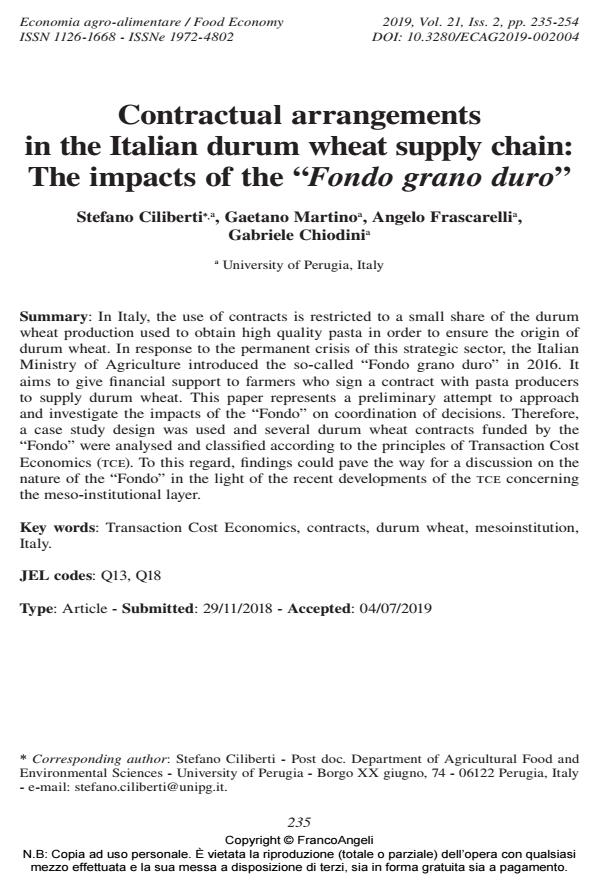Contractual arrangements in the Italian durum wheat supply chain: The impacts of the "Fondo grano duro"
Titolo Rivista ECONOMIA AGRO-ALIMENTARE
Autori/Curatori Stefano Ciliberti, Gaetano Martino, Angelo Frascarelli, Gabriele Chiodini
Anno di pubblicazione 2019 Fascicolo 2019/2
Lingua Inglese Numero pagine 20 P. 235-254 Dimensione file 190 KB
DOI 10.3280/ECAG2019-002004
Il DOI è il codice a barre della proprietà intellettuale: per saperne di più
clicca qui
Qui sotto puoi vedere in anteprima la prima pagina di questo articolo.
Se questo articolo ti interessa, lo puoi acquistare (e scaricare in formato pdf) seguendo le facili indicazioni per acquistare il download credit. Acquista Download Credits per scaricare questo Articolo in formato PDF

FrancoAngeli è membro della Publishers International Linking Association, Inc (PILA)associazione indipendente e non profit per facilitare (attraverso i servizi tecnologici implementati da CrossRef.org) l’accesso degli studiosi ai contenuti digitali nelle pubblicazioni professionali e scientifiche
In Italy, the use of contracts is restricted to a small share of the durum wheat production used to obtain high quality pasta in order to ensure the origin of durum wheat. In response to the permanent crisis of this strategic sector, the Italian Ministry of Agriculture introduced the so-called "Fondo grano duro" in 2016. It aims to give financial support to farmers who sign a contract with pasta producers to supply durum wheat. This paper represents a preliminary attempt to approach and investigate the impacts of the "Fondo" on coordination of decisions. Therefore, a case study design was used and several durum wheat contracts funded by the "Fondo" were analysed and classified according to the principles of Transaction Cost Economics (tce). To this regard, findings could pave the way for a discussion on the nature of the "Fondo" in the light of the recent developments of the tce concerning the meso-institutional layer.
Parole chiave:Transaction Cost Economics, contracts, durum wheat, mesoinstitution, Italy.
Jel codes:Q13, Q18
- Matching ecological transition and food security in the cereal sector: The role of farmers' preferences on production contracts Stefano Ciliberti, Angelo Frascarelli, Gaetano Martino, in Frontiers in Sustainable Food Systems 1114590/2023
DOI: 10.3389/fsufs.2023.1114590
Stefano Ciliberti, Gaetano Martino, Angelo Frascarelli, Gabriele Chiodini, Contractual arrangements in the Italian durum wheat supply chain: The impacts of the "Fondo grano duro" in "ECONOMIA AGRO-ALIMENTARE" 2/2019, pp 235-254, DOI: 10.3280/ECAG2019-002004